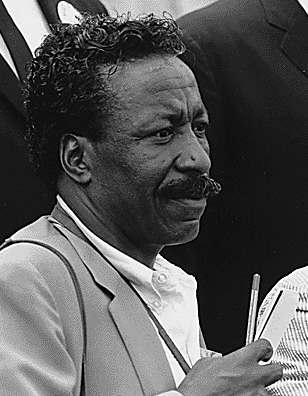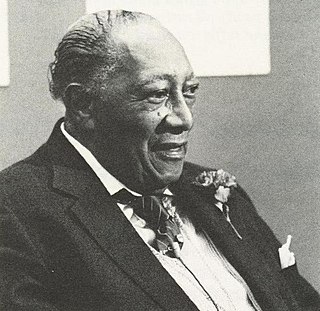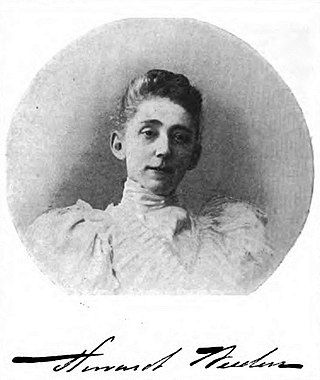
André Kertész, born Andor Kertész, was a Hungarian-born photographer known for his groundbreaking contributions to photographic composition and the photo essay. In the early years of his career, his then-unorthodox camera angles and style prevented his work from gaining wider recognition. Kertész never felt that he had gained the worldwide recognition he deserved. Today he is considered one of the seminal figures of 20th century photography.

Gordon Roger Alexander Buchanan Parks was an American photographer, composer, author, poet, and film director, who became prominent in U.S. documentary photojournalism in the 1940s through 1970s—particularly in issues of civil rights, poverty and African Americans—and in glamour photography. He is best remembered for his iconic photos of poor Americans during the 1940s, for his photographic essays for Life magazine, and as the director of the films Shaft, Shaft's Big Score and the semiautobiographical The Learning Tree.

James Augustus Van Der Zee was an American photographer best known for his portraits of black New Yorkers. He was a leading figure in the Harlem Renaissance. Aside from the artistic merits of his work, Van Der Zee produced the most comprehensive documentation of the period. Among his most famous subjects during this time were Marcus Garvey, Bill "Bojangles" Robinson and Countee Cullen.
William Levi Dawson was an American composer, choir director, professor, and musicologist.

Robert Russa Moton was an American educator and author. He served as an administrator at Hampton Institute. In 1915 he was named principal of Tuskegee Institute, after the death of founder Booker T. Washington, a position he held for 20 years until retirement in 1935.

Laura Gilpin was an American photographer.

Antoinette Frissell Bacon, known as Toni Frissell, was an American photographer, known for her fashion photography, World War II photographs, and portraits of famous Americans, Europeans, children, and women from all walks of life.
Orde Musgrave Coombs was an African-American writer and editor.
Songs of My People was a book, exhibition and multimedia project created and edited by organizers Eric Easter, Dudley M. Brooks and D. Michael Cheers. The book was published in February 1992 by Little, Brown, with an introduction by famed African American photographer Gordon Parks.

Lonnie George Johnson is an American inventor, aerospace engineer, and entrepreneur, whose work includes a U.S. Air Force-term of service and a twelve-year stint at NASA, where he worked at the Jet Propulsion Laboratory. He invented the Super Soaker water gun in 1989, which has been among the world's bestselling toys ever since.

Milton Pitts Crenchaw was an American aviator who served with the Tuskegee Airmen during World War II and was the first Arkansan to be trained by the federal government as a civilian licensed pilot. He served during World War II as a civilian flight instructor. He was one of the two original supervising squadron members. In 1998 he was inducted into the Arkansas Aviation Hall of Fame. The grandson of a slave, he was known as the "father of black aviation in Arkansas" who broke through color barriers in the military.
Rosalind Fox Solomon is an American photographer based in New York City.

Betsy Graves Reyneau (1888–1964) was an American painter, best known for a series of paintings of prominent African Americans for the exhibition “Portraits of Outstanding Americans of Negro Origin” that, with those by Laura Wheeler Waring and under the Harmon Foundation, toured the United States from 1944 to 1954. A granddaughter of Michigan Supreme Court Justice Benjamin F. Graves, Reyneau's sitters included Mary McLeod Bethune, George Washington Carver, Joe Louis, and Thurgood Marshall. Reyneau's portrait of Carver, the most famous, was the first of an African American to enter a national American collection.

Charles Alfred Anderson Sr., was an American aviator who is known as the Father of Black Aviation. He earned the nickname "Chief" as chief flight instructor of the Tuskegee Airmen.

Cornelius Marion Battey was an American photographer who shot photographic portraits of black Americans in a pictorialist style. His photograph of black leaders appeared on the cover of the NAACP's magazine The Crisis beginning in the 1910s. He later founded and headed up the photography department at the Tuskegee Institute.
Prentice Herman Polk was an American photographer known for his portraits of African Americans. He also served for several years as head of the Tuskegee Institute's Department of Photography.

Maria Howard Weeden, who signed her work and published as Howard Weeden, was an American artist and poet based in Huntsville, Alabama. After the American Civil War, she began to sell works she painted, which included portraits of many African-American freedmen and freedwomen. She exhibited her work in Berlin and Paris in 1895, where it was well received. She published four books of her poetry from 1898 to 1904, illustrated with her own art. She was posthumously inducted into the Alabama Women's Hall of Fame in 1998.
Robert William Deiz was a U.S. Army Air Force/U.S. Air Force officer, prominent combat fighter pilot, and Flight A leader with the 332nd Fighter Group's 99th Fighter Squadron, a component of the Tuskegee Airmen. He was one of the 1,007 documented Tuskegee Airmen Pilots.












